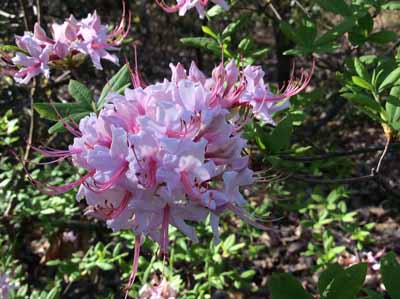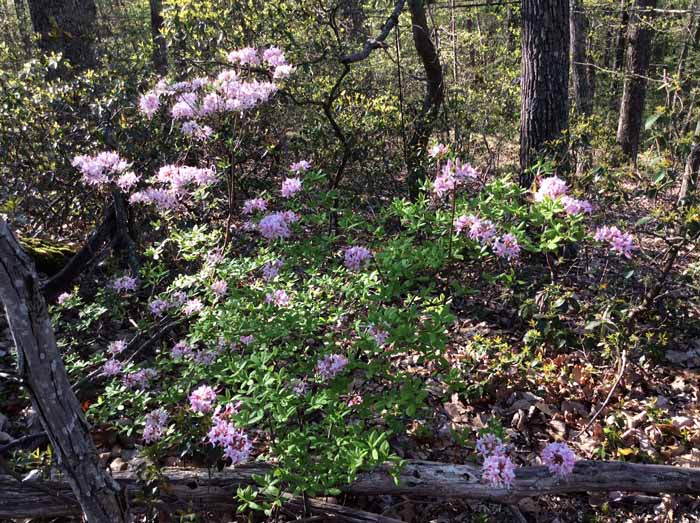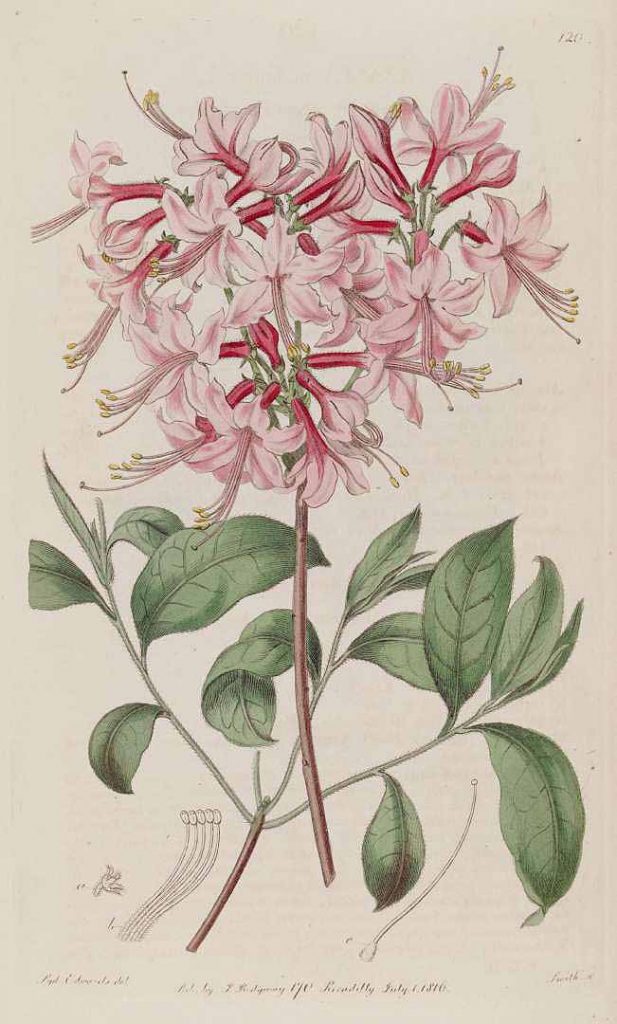
04.14.20 Pinkster Blummies
 This stunning flower is Mountain Azalea known as Rhododendron canescens or Azalea nudiflora (nudiflora referring to the appearance of flowers before the leaves). It is very showy for a wildflower, seeming to have escaped from some well-managed garden. It is native to the Appalachian forest. The colonial botanist, John Bartram, was an early collector of the plant, sharing it with his European correspondents. It is also known as “Pinkster Flower,” a name which reveals a complex lineage. Pinkster was an eighteenth- and early nineteenth-century festival for African Americans in and around New York. Pinkster was a variation on the Dutch “Pinksteren” or Pentecost. This late spring celebration developed into a time for African Americans, both enslaved and free, to travel to central locations to reconnect and celebrate life changes. It evolved into what has been described as a carnival atmosphere, especially in the New York City area. The wild pink azalea, blooming at that time in New York, became a common decoration on outfits and in parades. They were known as “pinkster blummies.”
This stunning flower is Mountain Azalea known as Rhododendron canescens or Azalea nudiflora (nudiflora referring to the appearance of flowers before the leaves). It is very showy for a wildflower, seeming to have escaped from some well-managed garden. It is native to the Appalachian forest. The colonial botanist, John Bartram, was an early collector of the plant, sharing it with his European correspondents. It is also known as “Pinkster Flower,” a name which reveals a complex lineage. Pinkster was an eighteenth- and early nineteenth-century festival for African Americans in and around New York. Pinkster was a variation on the Dutch “Pinksteren” or Pentecost. This late spring celebration developed into a time for African Americans, both enslaved and free, to travel to central locations to reconnect and celebrate life changes. It evolved into what has been described as a carnival atmosphere, especially in the New York City area. The wild pink azalea, blooming at that time in New York, became a common decoration on outfits and in parades. They were known as “pinkster blummies.”

Illustration of the mountain azalea by S. Edwards appearing in the Botanical Register, 1815.
 Josef Beery
Josef Beery This stunning flower is Mountain Azalea known as Rhododendron canescens or Azalea nudiflora (nudiflora referring to the appearance of flowers before the leaves). It is very showy for a wildflower, seeming to have escaped from some well-managed garden. It is native to the Appalachian forest. The colonial botanist, John Bartram, was an early collector of the plant, sharing it with his European correspondents. It is also known as “Pinkster Flower,” a name which reveals a complex lineage. Pinkster was an eighteenth- and early nineteenth-century festival for African Americans in and around New York. Pinkster was a variation on the Dutch “Pinksteren” or Pentecost. This late spring celebration developed into a time for African Americans, both enslaved and free, to travel to central locations to reconnect and celebrate life changes. It evolved into what has been described as a carnival atmosphere, especially in the New York City area. The wild pink azalea, blooming at that time in New York, became a common decoration on outfits and in parades. They were known as “pinkster blummies.”
This stunning flower is Mountain Azalea known as Rhododendron canescens or Azalea nudiflora (nudiflora referring to the appearance of flowers before the leaves). It is very showy for a wildflower, seeming to have escaped from some well-managed garden. It is native to the Appalachian forest. The colonial botanist, John Bartram, was an early collector of the plant, sharing it with his European correspondents. It is also known as “Pinkster Flower,” a name which reveals a complex lineage. Pinkster was an eighteenth- and early nineteenth-century festival for African Americans in and around New York. Pinkster was a variation on the Dutch “Pinksteren” or Pentecost. This late spring celebration developed into a time for African Americans, both enslaved and free, to travel to central locations to reconnect and celebrate life changes. It evolved into what has been described as a carnival atmosphere, especially in the New York City area. The wild pink azalea, blooming at that time in New York, became a common decoration on outfits and in parades. They were known as “pinkster blummies.”